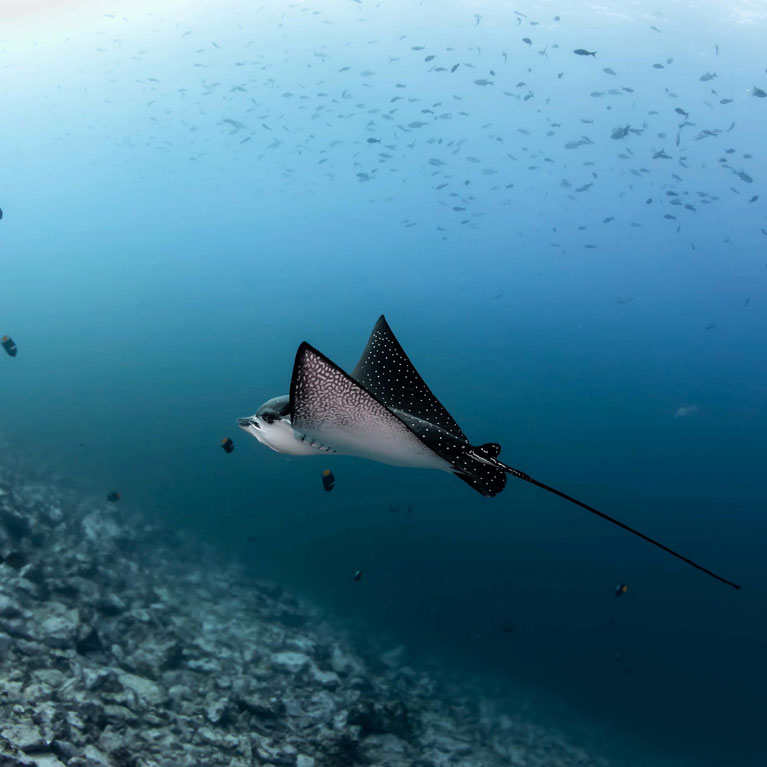Connecting the dots: population genetics of Pacific spotted eagle-rays
The Pacific spotted eagle-ray is genetically unique to the Eastern Tropical Pacific. Laura is working to characterise the genetic diversity and population structure of populations of this eagle-ray around Colombia’s Malpelo Island. Her project marks a first for the country, and she wants to understand the rays protected in the Malpelo Marine Protected Area as well as their genetic ties to other populations around the Eastern Tropical Pacific. This project is laying the groundwork for vital ray research and conservation management in Colombia.
Born in Manizales, Colombia, I am passionate about marine megafauna and particularly interested in marine science, bio-acoustics and genetics. I have been a biology student at the Universidad de Caldas in Manizales since 2019 and during this time I’ve been leading the bio-acoustics and eco-acoustics research group and, as a volunteer investigator at R&E Ocean Community Conservation Foundation, conducting research on marine megafauna and working alongside local communities in the Colombian Pacific region, Chocó. As an early-career scientist, since 2022 I have been participating in multiple projects relating to topics such as acoustic diversity in anurans in and...
Eastern Tropical Pacific: Population genetics of Aetobatus laticeps using mtDNA haplotypes from Malpelo Island, Colombia
Our key objective is to study the genetic diversity and population structure of the Pacific spotted eagle-ray around Malpelo Island using molecular tools to understand how these rays are connected to other populations across the Eastern Tropical Pacific. This will provide important information to help protect and conserve this Vulnerable species.
The Pacific spotted eagle-ray faces increasing threats from overfishing, habitat degradation and climate change. The findings of this pioneering genetic study in Colombia will provide critical data on the species’ genetic diversity and connectivity, which are essential for the design of evidence-based conservation strategies and will make a meaningful impact on safeguarding the long-term protection of eagle-ray populations in the region.
The Pacific spotted eagle-ray Aetobatus laticeps is a fascinating species known for its dark body and numerous white spots on its back that forma unique pattern, making individuals easy to recognise. It typically inhabits shallow coastal waters, such as coral reefs and estuarine bays, across the Eastern Pacific from Baja California to northern Peru, including the Galápagos and Colombia’s Malpelo Island. The latter site is a marine protected area that hosts a range of unique marine and terrestrial species, making it an important region for conservation.
Currently, the Pacific eagle-ray is classified on the IUCN Red List of Threatened Species as Vulnerable, as it faces significant threats like overfishing and habitat degradation that are causing its population numbers to decrease. Recent genetic research has shown that while there are related eagle-rays in the Atlantic and Indo-Pacific, this species is unique to the Eastern Pacific. Morphological evidence supports this. Yet little genetic research has been done on the Pacific spotted eagle-ray globally, and specifically in Colombia no genetic studies have been published to date. This highlights the importance of intensifying research and conservation efforts on this species.
This project aims to fill this knowledge gap by studying the genetic diversity and population structure of the Pacific spotted eagle-ray. By analysing DNA from samples collected at Malpelo Island and making use of molecular markers and genetic sequences available in genomic repositories, this study will offer crucial insights and provide a baseline that could help guide future conservation efforts and strategies for the protection of eagle-ray populations in Colombia.
- To evaluate the genetic diversity and population structure of Pacific spotted eagle-ray populations around Malpelo Island and in the Eastern Tropical Pacific.
- To assess the genetic connectivity of Pacific spotted eagle-ray populations between Malpelo Island and other regions of the Eastern Tropical Pacific in order to make a contribution to future conservation strategies.
- To lay the groundwork for future research, which is crucial to protect the ray species in Colombia.


